Tourism in Croatia
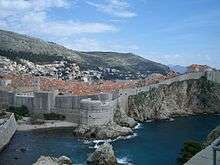
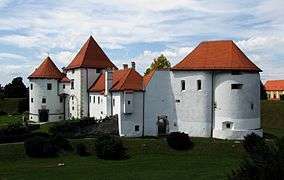
Tourism is a major industry in Croatia. In 2012, Croatia had 11.8 million tourist visitors,[1] and in 2013 over 14 million tourists and 73.25 million nights.[2][3] a record number of visitors. Croatia aims to double these numbers by 2020 with national strategy to bring in 17.5 million foreign tourist and revenue from tourism exceeding $17 billion.[4]
Tourism in Croatia is concentrated in the areas along the Adriatic coast and is strongly seasonal, peaking in July and August.[5]
Eight areas in the country have been designated national parks, and the landscape in these areas is afforded extra protection from development. Several companies run flotillas of yachts along different stretches of the coastline, which is also popular with divers.
Lonely Planet named Croatia as the top pick destination for 2005,[6] while National Geographic Adventure Magazine named Croatia as Destination of the Year in 2006.[7]
Tourist regions
The Croatian National Tourist Board has divided Croatia into six distinct tourist regions.
Istria

The west coast of the peninsula of Istria has several historical towns dating from Roman times, such as the city of Umag, which hosts the yearly Croatia Open ATP tennis tournament on clay courts.[8]
The city of Poreč is known for the UNESCO-protected Euphrasian Basilica, which includes 6th century mosaics depicting Byzantine art.[9] The city plan still shows the ancient Roman Castrum structure with main streets Decumanus and Cardo Maximus still preserved in their original forms. Marafor is a Roman square with two temples attached. One of them, erected in the 1st century, is dedicated to the Roman god Neptune.[10] Originally a Gothic Franciscan church built in the 13th century, the 'Dieta Istriana' hall was remodeled in the Baroque style in the 18th century.
The region's largest city Pula has one of the best preserved Amphitheaters in the world, which is still used for festivals and events. It is surrounded by hotel complexes, resorts, camps, and sports facilities. Nearby is Brijuni national park, formerly the summer residence of Josip Broz Tito.[11] Roman villas and temples still lie buried among farm fields and along the shoreline of surrounding fishing and farming villages. The coastal waters offer beaches, fishing, wreck dives to ancient Roman galleys and World War I warships, cliff diving, and sailing.[12] Pula is the end point of the EuroVelo 9 cycle route that runs from Gdańsk on the Baltic Sea through Poland, the Czech Republic, Austria, Slovenia and Croatia.
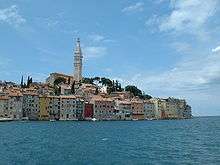
The town of Rovinj contains well-indented coastal areas with a number of small bays hidden within dense vegetation, open to naturists. Although the beaches are not specified as naturist, naturists frequent them.[13]
The interior is green and wooded, with small stone towns on hills, such as Motovun. The river Mirna flows below the hill. On the other side of the river lies Motovun forest, an area of about 10 square kilometres in the valley of the river Mirna, of which 280 hectares (2.8 km2) is specially protected. This area differs not only from the nearby forests, but also from those of the entire surrounding karst region because of its wildlife, moist soil, and truffles (Tuber magnatum) that grow there. Since 1999, Motovun has hosted the international Motovun Film Festival for independent films from the U.S. and Europe.[14] Groznjan, another hill town, hosts a three-week jazz festival every July.
Kvarner and Highlands

One of the most varying regions, the entire Kvarner gulf provides striking scenery, with tall mountains overlooking large islands in the sea. Opatija is the oldest tourist resort in Croatia, its tradition of tourism ranging from the 19th century.
The former Venetian island towns of Rab and Lošinj are popular tourist destinations. The island of Rab is rich in cultural heritage and cultural-historical monuments. Rab is also known as a pioneer of naturism after the visit of King Edward VIII and Mrs Wallis Simpson.[15] The island offers nature, beaches, heritage, and events such as the Rab arbalest tournament and the Rab Medieval festival - Rapska Fjera. With around 2600 hours of sunshine a year, the island of Lošinj is a tourist destination for Slovenians, Italians, and Germans in the summer months. Average air humidity is 70%, and the average summer temperature is 24 °C (75 °F) and 7 °C (45 °F) during the winter.[16]
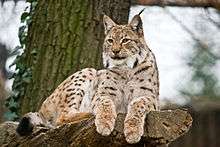
The interior regions Gorski kotar, Velebit and Lika have mountain peaks, forests and fields, many animal species including bears, and the national parks of Risnjak and Plitvice Lakes. The Plitvice Lakes National Park lies in the Plitvice plateau which is surrounded by three mountains part of the Dinaric Alps: Plješevica mountain (Gornja Plješevica peak 1,640 m), Mala Kapela mountain (Seliški Vrh peak at 1,280 m), and Medveđak (884 m).[17] The national Park is underlain by karstic rock, mainly dolomite and limestone with associated lakes and caves, this has given rise to the most distinctive feature of its lakes. The lakes are separated by natural dams of travertine, which is deposited by the action of moss, algae, and bacteria. The encrusted plants and bacteria accumulate on top of each other, forming travertine barriers which grow at the rate of about 1 cm per year. The sixteen lakes are separated into an upper and lower cluster formed by runoff from the mountains, descending from an altitude of 636 to 503 m (2,087 to 1,650 ft) over a distance of some eight km, aligned in a south-north direction.
.jpg)
The lakes collectively cover an area of about two square kilometers, with the water exiting from the lowest lake to form the Korana River. The lakes are divided into the 12 Upper Lakes (Gornja jezera) and the four Lower Lakes (Donja jezera):[18] Under the travertine waterfalls Cratoneuron moss sometimes grows, the moss gets encrusted with travertine and fresh moss grows further out, first a crag is formed but later a cave roof forms under the crag. If the water continues flowing the cave becomes progressively bigger. Limestone caves are present as well.[18] The area is also home to an extremely wide variety of animal and bird species. Rare fauna such as the European brown bear, wolf, eagle, owl, lynx, wild cat, and capercaillie can be found there, along with many more common species. At least 126 species of birds have been recorded there, of which 70 have been recorded as breeding.
Dalmatia
Zadar

This region caters to yachting and leisure travel. The Kornati National Park has hundreds of mostly uninhabited islands. Kornat, the biggest of the islands with a total area of 32,525,315 m2 (350,099,577 sq ft), comprises two-thirds of the park's land area. Although the island is 25.2 km long, it is no wider than 2.5 km.[19] The park is managed from the town of Murter, on the island of Murter, and is connected to the mainland by a drawbridge.
Zadar, the largest city in the region, gained its urban structure in Roman times; during the time of Julius Caesar and Emperor Augustus, the town was fortified and the city walls with towers and gates were built. On the western side of the town were the forum, the basilica and the temple, while outside the town were the amphitheatre and cemeteries. The aqueduct which supplied the town with water is partially preserved. Inside the ancient town, a medieval town had developed with a series of churches and monasteries being built.[20]

The interior has mixed plains and mountains, with the Paklenica canyon as the main attraction. Paklenica National Park is the most visited climbing site in Croatia, and the largest in Southeast Europe. The close proximity of seawater allows tourists to combine climbing, hiking and water sports. There are over 360 equipped and improved routes of various difficulty levels and lengths within Paklenica’s climbing sites.[21] The main climbing season begins in spring and ends in late autumn. The Park area contains 150–200 km of trails and paths intended either for tourists or mountaineers. The trails in the Park are marked with boards and mountaineering signs.
The island of Pag has one of the biggest party zones in Europe in the town of Novalja and Zrće. These beaches have all-hours discotheques and beach bars operating during summer months.[22]
Zadar is connected by land with two exits from the main highway, and by sea with regular line with Ancona, Italy, and by Air mostly with Ryanair, Germanwings and Croatia Airlines. Many tourist agencies and tourist service providers such as Croatica.eu offer group plans. Most tours are offered by local private owners and small local companies.
Šibenik
.jpg)
This is another yachting region, dotted with islands, and centered on Šibenik and the Cathedral of St. James, a UNESCO World Heritage site.[23] Several fortresses, remnants of the Renaissance era (which includes St. Nicholas Fortress) surround the city.
The interior has the Krka National Park with waterfalls and religious monasteries.[24] Skradinski Buk has attractions and facilities available among various footpaths, sightseeing tours and presentations, boat trips, restaurants and a museum. Roški Slap, located near Miljevci, is the second most popular attraction of the Krka National Park in terms of numbers of visitors, and whose cascades can be visited throughout the year. Roški Slap may be reached by excursion boat operated by the Krka National Park, although the falls can also be reached with a public road. Inside the park is the island of Visovac which was founded during the reign of Louis I of Hungary, home to the Roman Catholic Visovac Monastery founded by the Franciscans in 1445 near Miljevci village.[25] The island can be visited by a boat tour from Skradinski Buk. The park also includes the Serb Orthodox Monastery Krka founded in 1345.
The area around thecity of Knin has medieval fortresses and archeological remains. The recently discovered Roman town Burnum is 18 km far from Knin in direction of Kistanje, which has the ruins of the biggest amphitheater in Dalmatia built in 77 AD, which held 8,000 people, during the rule of Vespasian.[26] The nearby villages Biskupija and Kapitul are archaeological sites from the 10th century where remains of medieval Croatian culture are found including churches, graves, decorations, and epigraphs.[27]
Split
The coastal city of Split is also the second largest city in Croatia, and is known for its unique Roman heritage which includes UNESCO-protected Diocletian's Palace.[28] The city was built around the well-preserved palace, which is one of the most complete architectural and cultural features on the Croatian Adriatic coast. The Split Cathedral stems from the palace.

The Makarska Riviera is a stretch of coastline that offers beaches, clubs, cafes, kayaking, sailing, and hiking along the Biokovo range. Makarska, Brela, Omiš, and Baška Voda are the most popular.
The large islands of this region, include the town of Hvar, known for its fishing and tourism industries. Hvar has a mild Mediterranean climate and Mediterranean vegetation. The island promotes itself as "the sunniest spot in Europe", with over 2715 hours of sunlight in an average year.[29] Cultural and artistic events within the Hvar Summer Festival take place throughout the summer, from late June to late September. These events include classical music concerts performed by national and international artists, and performances by amateur groups from Hvar.[30] The Gallery of Modern Art in Hvar is located in the Arsenal building, in the lobby of the historic Theatre of Hvar. The permanent display contains paintings, sculptures, and prints from the collection, and temporary exhibitions are organised within the Museum project Summer of Fine Arts in Hvar.[31]
The Cathedral of St. Stephen and the Bishop's Palace have a Renaissance-baroque style, and a façade with three-cornered gable and a Renaissance Bell Tower in Romanesque style from the 16th century, created by Venetian artists.[32]
Other notable islands in the region include Brač, Čiovo, Šolta, and Vis.

The old city of Trogir is a UNESCO World Heritage Site and contains a mixture of influence from the Hellenistic period, Romans, and Venetians with its Greek architecture, Romanesque churches, Renaissance and Baroque buildings.[33] Trogir is the best-preserved Romanesque-Gothic complex in Central Europe. Trogir's medieval core, surrounded by walls, comprises a preserved castle and tower and a series of dwellings and palaces from the Romanesque, Gothic, Renaissance and Baroque periods. Trogir's grandest building is the Cathedral of St. Lawrence, whose main west portal is a masterpiece by Radovan, and the most significant work of the Romanesque-Gothic style in Croatia. Another notable attraction is the Fortress Kamerlengo
Dubrovnik

One of the best-known Croatian tourist sites is the fortified city of Dubrovnik with its Renaissance culture. The highlight is the Sponza Palace which dates from the 16th century and is currently used to house the National Archives.[34] The Rector's Palace is a Gothic-Renaissance structure that now houses a museum.[35][36] Its façade is depicted on the reverse of the Croatian 50 kuna banknote, issued in 1993 and 2002.[37]
The St. Saviour Church is another remnant of the Renaissance period, next to the Franciscan Monastery.[38][39][40] The Franciscan monastery's library possesses 30,000 volumes, 22 incunabula, 1,500 valuable handwritten documents. Exhibits include a 15th-century silver-gilt cross and silver thurible, an 18th-century crucifix from Jerusalem, a martyrology (1541) by Bemardin Gucetic and illuminated Psalters.[38] Dubrovnik's most famous church is St Blaise's church, built in the 18th century in honor of Dubrovnik's patron saint. Dubrovnik's baroque Cathedral houses relics of Saint Blaise. The city's Dominican Monastery resembles a fortress on the outside but the interior contains an art museum and a Gothic-Romanesque church.[41][42] A special treasure of the Dominican monastery is its library with over 220 incunabula, numerous illustrated manuscripts, a rich archive with precious manuscripts and documents and an extensive art collection.[43][44][45] The main feature of Dubrovnik is its walls that run 2 km around the city. The walls run from four to six metres thick on the landward side but are thinner on the seaward side. The system of turrets and towers were intended to protect the city.[46]
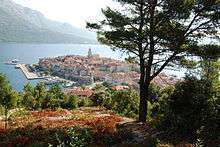
Just off the coast of Dubrovnik is the forested island of Lokrum. The small island has a castle, a thousand-year-old Benedictine monastery, and a botanical garden initially started by archduke Maximilian in the 19th century. Peacocks and peahens still roam the isle, descended from the original peafowls brought over by Maximilian.
The nearby islands include the historical island of Korčula. The Catholic inhabitants of Korčula keep alive old folk church ceremonies and a weapon dance, the Moreška, which dates back to the middle ages.[47] Originally danced only on special occasions, in modern times there are performances twice a week for tourists.[48] The main town's historic sites include the central Romanesque-Gothic Cathedral of St Mark (built from 1301 to 1806), the 15th-century Franciscan monastery with Venetian Gothic cloister, the civic council chambers, the palace of the former Venetian governors, grand 15th and 16th-century palaces of the local merchant nobles, and the city fortifications.

Further along the Adriatic are the forests of Mljet island. Over 72% of the island of 98.01 square kilometres (37.84 sq mi) is forest. Its geological structure consists of limestone and dolomite forming ridges, crests and slopes. A few depressions on the island of Mljet are below sea level and are known as blatine ("mud-lakes") or slatine ("salt-lakes"). During the rain seasons all blatine are filled with water and turn to brackish during dry seasons.
Central Croatia
The northern part of this region, with the hilly area of Zagorje, is dotted with castles and spas, and the old city of Varaždin. Varaždin, with its monuments and artistic heritage, represents the best preserved and richest urban complex in continental Croatia.
The Old Town (fortress) is a medieval defensive building. Construction began in the 14th century, and in the following century the rounded towers, typical of Gothic architecture in Croatia, were added. Varaždin's Cathedral, a former Jesuit church, was built in 1647, has a baroque entrance, 18th-century altar, and paintings.[49] Among festivals, the annual Špancir Fest begins at the end of August and ends in September (lasts for 10 days).[50] At this time the city welcomes artists, street performers, musicians and vendors for what is called 'the street walking festival'. Varaždin is also the host of the "Radar festival", which hosts concerts at the end of summer.[51] It has already hosted musical stars such as Bob Dylan, Carlos Santana, The Animals, Manic Street Preachers, Solomon Burke among others.
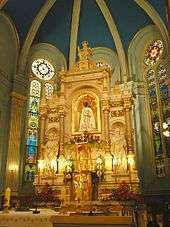
The Marian shrine of Marija Bistrica is the country's largest pilgrimage spot. Hundreds of thousands of pilgrims visit the site every year where the 14th-century church has stood. The church is known for the statue known as the "Black Madonna with Child," dating to the Turkish invasion in the 16th century when the statue was hidden in the church and then lost for decades until its discovery. Behind the church is the process of "The Way of the Cross", in which pilgrims begin the trek that leads to Calvary Hill. Pope John Paul II visited the site in 1998 in his second tour of Croatia.[52]
The south has some natural highlights, such as the nature park Lonjsko polje. The southwest area is known for its forests and wilderness. Baroque churches are found throughout the area, along with other cultural architecture.
Slavonia
Tourism in this region is just developing, mostly with spas. The area of Baranja has the national park of Kopački rit, a large swamp with a variety of fauna and birds. It is one of the largest and most attractive preserved intact wetlands in Europe, hosting about 260 various bird species such as (wild geese and ducks, great white egret, white stork, black stork, white-tailed eagle, crows, coots, gulls, terns, kingfishers, and European green woodpecker. Guided tourist visits by panoramic ships, boats, team of horses or on foot are available, with some packages offering the possibility of photographing or video-recording animals and birds.[53]
The cultural center is the historical city of Osijek, with its baroque style buildings, such as the Church of St. Peter and Paul, a neo-Gothic structure with the second highest tower in Croatia after the Zagreb Cathedral.
.jpg)
The Cathedral of St. Peter and St. Paul in Đakovo is the town of Đakovo's primary landmark and sacral object throughout the region of Slavonia.
There are three major yearly events celebrating folklore in Slavonia and Baranja: Đakovački vezovi, Vinkovačke jeseni and Brodsko kolo.[54] They present traditional folk costumes, folklore dancing and singing groups, customs, with a parade of horses and wedding wagons as a special part of the program. During the Đakovački vezovi, the Đakovo Cathedral hosts choirs, opera artists, and art exhibitions are organized in the exhibition salon, and during the sports program, pure-bred white Lipizzaner horses can be seen on the racecourse. Ilok and the war-torn city of Vukovar are also points of interest in the area.
Zagreb
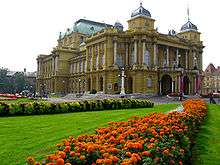
Like Prague or Budapest, Zagreb has a Central European feel to it, with a large and well-preserved old town on the hill and a 19th-century city center. The Croatian capital is also the country's largest cultural center, with many museums and galleries.
The historical part of the city to the north of Ban Jelačić Square is composed of the Gornji Grad and Kaptol, a medieval urban complex of churches, palaces, museums, galleries and government buildings that are popular with tourists on sightseeing tours. The historic district can be reached on foot, starting from Jelačić Square, the center of Zagreb, or by a funicular on nearby Tomićeva Street.
Around thirty collections in museums and galleries comprise more than 3.6 million various exhibits, excluding church and private collections. The Archaeological Museum consists of nearly 400,000 varied artifacts and monuments, have been gathered over the years from many different sources.[55] The most famous are the Egyptian collection, the Zagreb mummy and bandages with the oldest Etruscan inscription in the world (Liber Linteus Zagrabiensis), as well as the numismatic collection. The Croatian Natural History Museum holds one of the world's most important collection of Neanderthal remains found at one site.[56] These are the remains, stone weapons and tools of prehistoric Krapina man. The holdings of the Croatian Natural History Museum comprise more than 250,000 specimens distributed among various different collections.

There are about 20 permanent or seasonal theaters and stages. The Croatian National Theater in Zagreb was built in 1895 and opened by emperor Franz Joseph I of Austria. The most renowned concert hall is named "Vatroslav Lisinski", after the composer of the first Croatian opera was built in 1973. Animafest, the World Festival of Animated Films, takes place every even-numbered year, and the Music Bienniale, the international festival of avant-garde music, every odd-numbered year. It also hosts the annual ZagrebDox documentary film festival. The Festival of the Zagreb Philharmonic and the flowers exhibition Floraart (end of May or beginning of June), the Old-timer Rally annual events. In the summer, theater performances and concerts, mostly in the Upper Town, are organized either indoors or outdoors. The stage on Opatovina hosts the Zagreb Histrionic Summer theater events. Zagreb is also the host of Zagrebfest, the oldest Croatian pop-music festival, as well as of several traditional international sports events and tournaments. The Day of the City of Zagreb on November 16 is celebrated every year with special festivities, especially on the Jarun lake near the southwestern part of the city.
UNESCO World Heritage Sites
The United Nations Educational, Scientific and Cultural Organization (UNESCO) has included the following Croatian sites on its World Heritage List:
| Image | Name | Location | UNESCO data | Description |
|---|---|---|---|---|
| |
Plitvice Lakes National Park | Plitvička Jezera | 98; 1979; Natural; (vii, viii, ix) |
Over time, water has flowed over the natural limestone and chalk, creating natural dams which in turn have created a series of connecting lakes, waterfalls, and caves. The nearby forests are home to bears, wolves and many rare bird species. |
.jpg) |
Historical Complex of Split with the Palace of Diocletian | Split | 97; 1979; Cultural; (ii, iii, iv) |
The palace was built by the Roman emperor Diocletian at the turn of the 4th century AD, and later served as the basis of the city of Split. A cathedral was built in the Middle Ages inside the ancient mausoleum, along with churches, fortifications, Gothic and Renaissance palaces. The Baroque style makes up the rest of the area. |
 |
Old City of Dubrovnik | Dubrovnik | 95; 1979; Cultural; (i, iii, iv) |
Dubrovnik became a prosperous Maritime Republic during the Middle Ages, it became the only eastern Adriatic city-state to rival Venice. Supported by its wealth and skilled diplomacy, the city achieved a remarkable level of development, particularly during the 15th and 16th centuries. |
 |
Episcopal Complex of the Euphrasian Basilica in the Historic Centre of Poreč | Poreč | 809; 1997; Cultural; (ii, iv) |
The episcopal complex, with its striking mosaics dating back to the 6th century, exemplifies early Byzantine art and architecture in the Mediterranean region. It includes the basilica itself, a sacristy, a baptistery and the bell tower of the nearby archbishop's palace. |
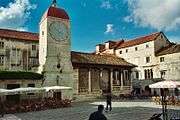 |
Historic city of Trogir | Trogir | 810; 1997; Cultural; (ii, iv) |
Trogir's rich culture was created under the influence of old Greeks, Romans, and Venetians. It is the best-preserved Romanesque-Gothic in Central Europe. Trogir's medieval core, surrounded by walls, comprises a preserved castle and tower and a series of dwellings and palaces from the Romanesque, Gothic, Renaissance and Baroque periods. |
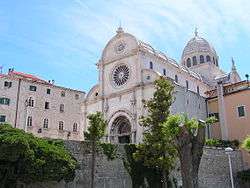 |
Cathedral of Saint James | Šibenik | 963; 2000; Cultural; (i, ii, iv) |
The cathedral is a triple-nave basilica with three apses and a dome (32 m high inside) and is also a significant architectural monument of the Renaissance in the eastern Adriatic. |
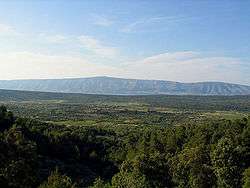 |
Stari Grad Plain | Hvar | 1240; 2008; Cultural; (ii, iii, v) |
The Stari Grad Plain is an agricultural landscape that was set up by the ancient Greek colonists in the 4th century BC, and remains in use today. The plain is mostly still in its original form. The ancient layout has been preserved by careful maintenance of the stone walls over 2,400 years. |
Statistics by year
| Year | Total tourist arrivals[57] | Total tourist nights[57] | Notes |
|---|---|---|---|
| 1985 | 10,125,000 | 67,665,000 | |
| 1986 | 10,151,000 | 68,216,000 | |
| 1987 | 10,487,000 | 68,160,000 | |
| 1988 | 10,354,000 | 67,298,000 | |
| 1989 | 9,670,000 | 61,849,000 | |
| 1990 | 8,497,000 | 52,523,000 | First democratic elections Early Log Revolution-related incidents |
| 1991 | 2,297,000 | 10,471,000 | Croatian War of Independence begins Siege of Dubrovnik |
| 1992 | 2,135,000 | 11,005,000 | |
| 1993 | 2,514,000 | 13,208,000 | |
| 1994 | 3,655,000 | 20,377,000 | |
| 1995 | 2,610,000 | 13,151,000 | End of Croatian War of Independence |
| 1996 | 4,186,000 | 21,860,000 | |
| 1997 | 5,585,000 | 30,775,000 | |
| 1998 | 5,852,000 | 31,852,000 | |
| 1999 | 5,127,000 | 27,126,000 | NATO bombing of neighbouring FR Yugoslavia |
| 2000 | 7,137,000 | 39,183,000 | |
| 2001 | 7,860,000 | 43,404,000 | |
| 2002 | 8,320,000 | 44,692,000 | |
| 2003 | 8,878,000 | 46,635,000 | |
| 2004 | 9,412,000 | 47,797,000 | |
| 2005 | 9,995,000 | 51,421,000 | |
| 2006 | 10,385,000 | 53,007,000 | |
| 2007 | 11,162,000 | 56,005,000 | |
| 2008 | 11,261,000 | 57,103,000 | |
| 2009 | 10,935,000 | 56,301,000 | Global financial crisis |
| 2010 | 10,604,116 | 56,416,379 | |
| 2011 | 11,200,113 | 65,116,830 | |
| 2012 | 12,300,000 | 70,300,000 | |
| 2013 | 14,000,000 | 73,250,000 | |
| 2014[58] | 13,128,416 | 66,483,948 | |
| 2015[59] | 14,150,000 | 78,589,000 | |
Arrivals by country
Most visitors arriving to Croatia on short term basis in 2015 were from the following countries of nationality:[60]
| Rank | Country | Number |
|---|---|---|
| 1 | 2,124,149 | |
| 2 | 1,191,998 | |
| 3 | 1,119,709 | |
| 4 | 1,111,428 | |
| 5 | 696,151 | |
| 6 | 674,779 | |
| 7 | 490,510 | |
| 8 | 466,045 | |
| 9 | 435,990 | |
| 10 | 380,942 | |
| Other | 3,991,478 | |
| Total | 12,683,179 |
See also
References
- ↑ "HRK 6 Billion to be invested in new tourist season". 2006. Retrieved 2008-02-04.
- ↑ http://www.mint.hr/UserDocsImages/htz-turizam-br012_HR.pdf
- ↑ http://press.croatia.hr/Documents/3030/Dolasci-i-nocenja-turista-sijecanj-PROSINAC-2013-2012.pdf
- ↑ "Cilj je udvostručiti potrošnju do 2020.". Poslovni dnevnik. Retrieved 9 June 2015.
- ↑ "Tourism statistics for Croatia". ec.europa.eu. European Commission. 2014. Retrieved 10 September 2016.
- ↑ Lonely Planet. "Press releases – Press – Lonely Planet". Retrieved 9 June 2015.
- ↑ Jon Bowermaster, Destination of the Year: Exploring the New Croatia
- ↑ "Konzum Croatia Open Umag". ATP World Tour. Retrieved 9 June 2015.
- ↑ UNESCO World Heritage Centre. "Episcopal Complex of the Euphrasian Basilica in the Historic Centre of Poreč". Retrieved 9 June 2015.
- ↑ Frommer's Eastern Europe, by Ryan James, Hana Mastrini, Mark Baker, 2009.
- ↑ "BBC News - Inside Tito's luxury playground". Retrieved 9 June 2015.
- ↑ Croatian coast: A great place to learn to dive
- ↑ "Beaches in Rovinj". Retrieved 9 June 2015.
- ↑ About festival
- ↑ "Andrew Earnes goes island-hopping on the Croatian coast - on the cheap". the Guardian. Retrieved 9 June 2015.
- ↑ "About the island - Climate". Retrieved 9 June 2015.
- ↑ Plitvice Lakes National Park–Basic Information
- 1 2 Plitvička Jezera.hr
- ↑ Jeanne Oliver (2005), Croatia, pg. 187, Lonely Planet Publications, ISBN 1-74059-487-8
- ↑ Natalie Paris. "Zadar, Croatia: The perfect break". Telegraph.co.uk. Retrieved 9 June 2015.
- ↑ Paklenica National Park: climbing
- ↑ "Island-hopping in Croatia". the Guardian. Retrieved 9 June 2015.
- ↑ UNESCO World Heritage Centre. "The Cathedral of St James in Šibenik". Retrieved 9 June 2015.
- ↑ [Bradt Croatia: The Bradt Travel Guide, by Piers Letcher, Robin McKelvie, Jenny McKelvie. 2007]
- ↑ Naklada Naprijed, The Croatian Adriatic Tourist Guide, pg. 208, Zagreb (1999)]
- ↑ Andrea Devlahović. ".:: fragmenti ONLINE :::::::: f 1/I 2003. Burnum". Retrieved 9 June 2015.
- ↑ Sv. Ante Knin
- ↑ UNESCO World Heritage Centre. "Historical Complex of Split with the Palace of Diocletian". Retrieved 9 June 2015.
- ↑ Croatia, Island Hvar-Climate
- ↑ Tourist Board of City of Hvar, retrieved 14 July 2009
- ↑ The Hvar Heritage Museum, retrieved 14 July 2009
- ↑ Novak, Grga (1960) [1924], Hvar Kroz Stoljeća (Hvar Through the Centuries), Historijski Arhiv - Hvar (Historical Archives of Hvar) (in Croatian), I (2nd ed.), Narodni Odbor Općine Hvar (National Council of Hvar Municipality)
- ↑ UNESCO World Heritage Centre. "Historic City of Trogir". Retrieved 9 June 2015.
- ↑ "Sponza Palace". DubrovnikCity.com. Archived from the original on 2010-02-16. Retrieved 2010-02-16.
- ↑ "The Rector's Palace". DubrovnikCity.com. Archived from the original on 2010-02-16. Retrieved 2010-02-16.
- ↑ "The Rector's Palace". Dubrovnik Guide. Archived from the original on 2010-02-16. Retrieved 2010-02-16.
- ↑ Croatian National Bank. Features of Kuna Banknotes: 50 kuna (1993 issue) & 50 kuna (2002 issue). – Retrieved on 30 March 2009.
- 1 2 "Monuments (1 to 5)". Dubrovnik Online. Archived from the original on 2010-02-16. Retrieved 2010-02-16.
- ↑ "Franciscan monastery". Dubrovnik Guide. Archived from the original on 2010-02-16. Retrieved 2010-02-16.
- ↑ "Franciscan Friary, Dubrovnik". Sacred Destinations. Archived from the original on 2010-02-16. Retrieved 2010-02-16.
- ↑ "Church of St. Blaise, Dubrovnik". Sacred Destinations. Archived from the original on 2010-02-16. Retrieved 2010-02-16.
- ↑ "Monuments (16 to 20)". Dubrovnik Online. Archived from the original on 2010-02-16. Retrieved 2010-02-16.
- ↑ "Dominican Friary, Dubrovnik". Sacred Destinations. Archived from the original on 2010-02-16. Retrieved 2010-02-16.
- ↑ Oliver, Jeanne. "Dominican Monastery". Croatia Traveller. Archived from the original on 2010-02-16. Retrieved 2010-02-16.
- ↑ "Monuments (21 To 22)". Dubrovnik Online. Archived from the original on 2010-02-16. Retrieved 2010-02-16.
- ↑ Oliver, Jeanne. "Dubrovnik's Walls". Croatia Traveler. Archived from the original on 2010-02-16. Retrieved 2010-02-16.
- ↑ ""Blackened Faces and a Veiled Woman: The Early Korcula Moreska" by Harris, Max; Feldman, Lada Cale - Comparative Drama, Vol. 37, Issue 3-4, Fall-Winter 2003 - Online Research Library: Questia". Retrieved 9 June 2015.
- ↑ Dunin, Elsie Ivancich, ed. (2006). Korčulanska Moreska (in Croatian). ISBN 9789539547101.
- ↑ UNESCO World Heritage Centre. "Varazdin - Historic Nucleus and Old Town (the Castle)". Retrieved 9 June 2015.
- ↑ Spancirfest main page
- ↑ "Početna - Varaždinske barokne večeri". Retrieved 9 June 2015.
- ↑ Croatia by Vesna Marić, (2009)
- ↑ "Kopački Rit". Retrieved 9 June 2015.
- ↑ Hadžihusejnović-Valašek, Miroslava (March 1993). "Baranja je "tvrd orah". Analiza istraživanja i popularizacije tradicijske baranjske folklorne glazbe" [Baranja is "tough nut". Records and popularisation analysis of traditional Baranja folk music] (PDF). Studia ethnologica Croatica (in Croatian). Department of Ethnology and Cultural Anthropology, Faculty of Humanities and Social Sciences, University of Zagreb. 4 (1): 194. ISSN 1330-3627. Retrieved 2012-02-12.
- ↑ "The History and Activities of the Archeological Museum". Archived from the original on 2006-05-18. Retrieved 2006-07-02.
- ↑ "Croatian Natural History Museum". Retrieved 2006-07-02.
- 1 2 http://reports.aiidatapro.com/CBE/Tourism_2009.pdf
- ↑ http://www.mint.hr/UserDocsImages/150219_t-stat-014.pdf
- ↑ http://www.mint.hr/default.aspx?id=29626
- ↑
External links
| Wikivoyage has a travel guide for Croatia. |
- Croatian National Tourist Board
-
 Media related to Tourism in Croatia at Wikimedia Commons
Media related to Tourism in Croatia at Wikimedia Commons - Croatian Tourist Regions
